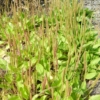Description
Plantago major | Broadleaf Plantain
There are more than 200 species of Plantain out there and are just about as many uses for this important herb, too! It’s a hardy, prolific, and highly adaptable herbaceous plant that grows from early spring to late autumn and thrives in poor, compacted soil. It’s commonly found growing in yards and gardens where pesticides are not used. Most commonly found in fields, lawns, roadsides, open woods, footpaths, and marginal areas throughout the temperate regions of the world as plants prefers cool temperatures in moist climates. Native Americans called this persistent herb “white man’s foot” as it was often found growing along well-trodden foot paths. Plantain is also known as a ‘peoples plant’ because it follows where people go. And while we’re often tempted to pull weeds to make space for more exciting plants to grow, it is important for biodiversity’s sake to grow plants like plantain to protect and enrich the soil and to offer medicinal and nutritional benefits to the end-user.
Plantain are easily identifiable by their tendency to lay flat on the ground and grow in areas that are often mowed or disturbed. Their most noticeable feature are the parallel veins that run vertically along the entire leaf, from stem to tip. Depending on the species, the dark-green leaves range from broadly ovate to narrow and lance-like. Flowers stalks of inconspicuous flowers are borne in early summer, then form brown seeds well into fall.
Plantago major, a Plantain variety with broad leaves, commonly known as Broad Leaf Plantain, Common Plantain, Greater Plantain, and Englishman’s Foot, is one of the most abundant and widely distributed medicinal crops in the world. It’s considered to be one of the nine sacred herbs by ancient Saxon people and has been celebrated as the ‘mother of herbs’ in the past.
Will reseed freely and as it spreads to cover an area the fibrous roots break up hard, compressed soils while simultaneously preventing erosion by holding the earth in place.
Plantain has been widely used for hundreds of years for coughs, bronchitis, tuberculosis, sore throat, laryngitis, urinary infections, and digestive problems. Packed with nutrients, the entire plant, from the roots to the leaves to the stems and seeds is edible and contains a number of constituents that are beneficial for both internal and external ailments which have been documented in herbal books dating as far back as the 1500’s. The main active chemical ingredients are aucubin (an anti-microbial agent), allantoin, (stimulates cellular growth and tissue regeneration) and mucilage (reduces pain and discomfort). The juice from crushed leaves may also stem the flow of blood from cuts, and soothe the itch of poison ivy or the sting of nettle (Urtica dioica ). The root of the herb has been used to relieve toothache . The juice may relieve earache and a decoction of Plantain has been used to ease the pain of ulcers and inflammation of the intestines.
Plantain is high in vitamins A, C and K, calcium, minerals, and dietary fiber. The young leaves can be eaten as a fresh vegetable and makes a great addition to salads. Cook the older more fibrous leaves as you would spinach or chop and add to stir fry or stews. The young green flower stalks can be eaten raw or cooked as a vegetable. Mature seeds can be collected, threshed and milled into a flour. The whole seed also makes a nutritious additive to rice or oatmeal. Poultices and detoxifying tea can also be made.
By embracing these plants, we protect our local groundwater and biodiversity; we reduce the amount of labor needed to maintain our yards; we protect the soil by keeping roots in the ground to support soil communities; and we diversify our diet.
Type: Perennial
Sun exposure: Full sun
Mature height: 6-16 inches
Mature width: 4-8 inches
Perennial zones: 3-9
Check out this great video by The Herbal Jedi:













